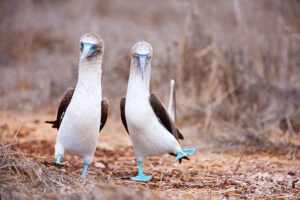
The term “Blue-Footed Booby Identification” alludes to an emphasis on characterizing and identifying the unique traits of this noteworthy seabird species, which is distinguished by its vivid blue feet. Sula nebouxii, or Blue-Footed Boobies, are distinguished by their remarkable physical characteristics and habits. These birds are easily identified by their striking brilliant blue feet contrasting with their brown or greyish plumage. An essential part of the visual communication that birds use during courtship displays is the intensity of their blue coloring, which is frequently linked to the health and vitality of the bird.
The size of a Blue-Footed Boobie is medium to large, with a wingspan of 60 to 90 centimeters. Their long, pointed wings add to their remarkable aerial skills, and their sleek bodies allow for practical flying and diving. The bill’s sharp point makes it perfect for snagging fish as they swiftly dive into the sea. Male Blue-Footed Boobies participate in complex courtship displays to entice females during the breeding season. Their health and genetic fitness are displayed through these demonstrations, which involve elevating and presenting their blue feet in a rhythmic dance. Potential partners find a male more attractive if his blue coloring is solid and brilliant.
The Pacific Ocean shores, especially those in Central and South America’s west, are home to Blue-Footed Boobies, along with several other islands. They establish colonies and build bare nests on the ground with the least materials. When it comes to their eating, Blue-Footed Boobies are expert hunters. They dive into the ocean from great heights to capture fish, tiny schooling species. They are an iconic and captivating species in maritime environments because of their extraordinary hunting skills and distinctive look.
Size and Shape
The Blue-Footed Booby is a medium-sized bird with a wingspan of between 60 and 90 centimeters. Its unique look distinguishes it. Its sleek body facilitates its remarkable flying and diving talents and long, pointed wings. The bill is filed and sharp, designed to catch fish at great speed when diving into the ocean. Males of these seabirds are typically slightly larger than females, exhibiting sexual dimorphism.

The most distinctive attribute that distinguishes the Blue-Footed Booby from other booby species is its vivid blue feet. When males exhibit their feet in a rhythmic dance to entice possible mates, the intensity of their blue coloring plays a crucial role. During the breeding season, the perception of the male’s attractiveness increases with the color of his foot. Beyond their eye-catching blue feet, Blue-Footed Boobies have plumage that is brown or greyish, which helps them blend in with the rocky coastal environments in which they frequently nest. They are successful hunters because of their overall colors and streamlined design, which enable them to dive quickly into the ocean and capture schools of fish.
Pattern of Colour
The Owl-Headed The striking vivid blue feet of the booby, along with its unique pattern of brown or greyish plumage, are what make it so famous. Its body plumage, usually grey or brown, helps it blend well with the coastal settings where it nests. Their coloring aids in their ability to blend in with the rocky surroundings and evade being seen by intruders or predators. Their feet’s vivid blue hue is, without a doubt, the most remarkable aspect. One of the most critical aspects of their visual communication during courtship displays is the intensity of the blue hue. Males display their incredibly blue feet in a ceremonial dance to entice females. Males are viewed as more attractive when their feet are blue, which suggests general health and genetic fitness.
The striking contrast between the vividly blue feet and the muted plumage intensifies during courtship displays, producing an incredibly alluring and distinctive sight. The Blue-Footed Booby’s distinct color pattern helps it stand out in its coastal and marine environments, in addition to having practical use in mating rituals.
Where do They Live
The eastern tropical Pacific, the shores of Central and South America, and numerous offshore islands are home to Blue-Footed Boobies. They are typically found on the western coasts of Mexico, Ecuador, Peru, and the Galápagos Islands. These seabirds are isolated islands, islets, and rugged coastal cliffs for breeding sites. Large colonies of Blue-Footed Boobies form during the breeding season, and they build their nests on rocky ledges or the ground. The locations of their chosen nests are close to abundant marine feeding grounds, which is necessary for the survival of the adults and the offspring.

Although they are primarily found in the eastern Pacific, reports of sightings outside their usual range have occurred. Oceanographic circumstances or shifts in food availability could be linked to these excursions. To successfully reproduce, they must find coastal and island habitats that provide ideal nesting locations and easy access to the nutrient-rich marine regions where they fish for food. With their distinctive blue feet, Blue-Footed Boobies are not only ideally suited to their coastal habitats but also serve as symbols of the distinct ecosystems that they live in around the Pacific coast.
FAQs
Q: Blue-Footed Boobies live where?
A: The eastern tropical Pacific, which includes the coasts of Central and South America as well as the Galápagos Islands, is home to the majority of Blue-Footed Boobies. They like to nest on isolated islands and steep coastal cliffs.
Q: Why do they go by the name “Blue-Footed”?
A: The remarkably vivid blue pigmentation of the foot of Blue-Footed Boobies is the source of their name. During the breeding season, the intensity of this blue tint is essential for their courtship displays.
Q: What makes their displays of courtship unique?
A: Male Blue-Footed Boobies engage in complex courtship rituals, exhibiting their vividly blue feet through dancing. The greater the blueness of the foot, a sign of genetic fitness, the more appealing the man is to prospective mates.
Q: What do Boobies with Blue Feet Eat?
A: Fish is the primary food source for Blue-Footed Boobies, tiny schooling species. They are expert hunters, diving from the air into the ocean to capture prey with their sharp bills and streamlined bodies.
Q: Do Blue-Footed Boobies face extinction?
A: According to the International Union for Conservation of Nature’s (IUCN) Red List, Blue-Footed Boobies are currently considered a species of “Least Concern”. Threats to local populations, though, could include habitat disruption and climate change.
Q: They move, do they?
A: It is not known that Blue-Footed Boobies migrate far. They usually stay within their range in the eastern tropical Pacific. However, there have been reports of sightings outside it on occasion.
Q: How are their nests constructed?
A: Nests are constructed by Blue-Footed Boobies on rocky ledges or the ground. Their nests are basic constructions composed of few materials that fit well in the island and coastal environments where they breed.
Q: Are Blue-Footed Boobies showing signs of parental concern?
A: Male and female Blue-Footed Boobies indeed take turns tending to the eggs and the young. Both parents help feed the chicks, and they alternately keep the eggs warm.
Q: Why does it matter that their feet are blue?
A: During courtship displays, the intensity of the blue color in their foot serves as a visual cue. The perception of males with bluer feet as more appealing is essential in choosing mates.
Q: Is it possible to find Blue-Footed Boobies outside of the Pacific?
A: Although they are mainly found in the eastern tropical Pacific, reports of sightings outside of their usual range are not uncommon. Variations in food availability or changes in the ocean’s environment may impact these excursions.





